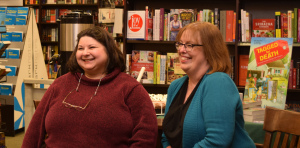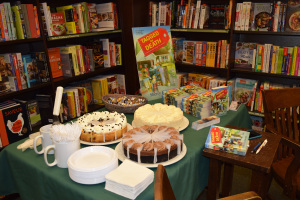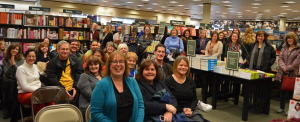Edith Maxwell's Blog, page 267
January 28, 2015
Wicked Wednesday — Comparable Titles and Marketing Plan
Today we end our month long series on writing a proposal (or do we — we have a special guest on Friday, January 30th) by talking about Comparable Titles and Marketing Plans. Even if you don’t have to write a proposal it’s important to know where your book would sit on the shelf of a bookstore and who will read it.
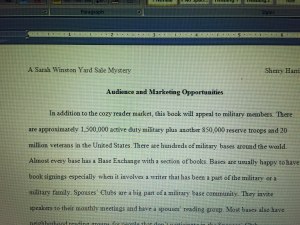 Sherry: The thought of finding comparable titles and writing a marketing plan probably intimidated me as much as writing the synopsis. I knew there wasn’t another cozy series with a garage sale theme on the market so I had to look at books that were similar. I googled books about estate sales and thrift shops. It was actually easier than I thought. The marketing plan might also be called your platform. Who is going to read your book? I pointed out that not only would cozy mystery readers enjoy the series but also people affiliated with the military as my protagonist, Sarah, is a former military spouse. Part of the action in each book takes place on a fictional military base. I also cited fans of yard sales and mentioned the popularity of shows on HGTV about yard sales and flea markets.
Sherry: The thought of finding comparable titles and writing a marketing plan probably intimidated me as much as writing the synopsis. I knew there wasn’t another cozy series with a garage sale theme on the market so I had to look at books that were similar. I googled books about estate sales and thrift shops. It was actually easier than I thought. The marketing plan might also be called your platform. Who is going to read your book? I pointed out that not only would cozy mystery readers enjoy the series but also people affiliated with the military as my protagonist, Sarah, is a former military spouse. Part of the action in each book takes place on a fictional military base. I also cited fans of yard sales and mentioned the popularity of shows on HGTV about yard sales and flea markets.
Jessie: I think this part of the proposal is really interesting to work on. It actually helps me to clarify for myself the sort of story I am trying to tell. I look at other work with similarities and by asking myself how mine is different I feel more sure of what it is I am really trying to write. Besides, searching the world for comparable also gives me a long list of great books to add to my reading list!
Edith: I agree about the list of great books to read, Jessie! For my proposals (three now 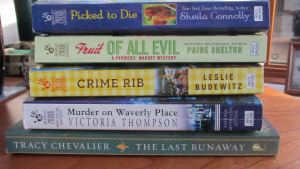 under my belt), looking for comparable series didn’t intimidate me. I was just glad that there were no others in my exact niche: organic farmer in New England. Country store/restaurant owner smack dab in the middle of the country. Quaker midwife in 1888. But for each I found several well-performing series tangentially related which showed that the general theme is popular, and I could riff part of the marketing plan off of those. Here’s what I wrote for the country store series:
under my belt), looking for comparable series didn’t intimidate me. I was just glad that there were no others in my exact niche: organic farmer in New England. Country store/restaurant owner smack dab in the middle of the country. Quaker midwife in 1888. But for each I found several well-performing series tangentially related which showed that the general theme is popular, and I could riff part of the marketing plan off of those. Here’s what I wrote for the country store series:
Small towns in southern Indiana represent a middle ground between the north and the south, and between the east and west coasts. Many readers long for the scenic and traditional life of rural America. Cozy mystery fans will enjoy a new culinary mystery series, fans of cookware will eat up descriptions of tools from the past, and puzzle aficionados will appreciate Robbie’s skills with everything from cryptic crosswords to Sudoku.
Liz: I enjoyed this piece as well. It was interesting to take a look at the other animal cozies out there and see what each author was doing with their four-legged characters. I knew right away I didn’t want my animals to solve mysteries, but I did want to take this opportunity to emphasize good animal care and work in the rescue theme as much as possible. So that’s what I focused on in the proposal for Pawsitively Organic while using the series comparisons to show how popular animals are as a theme overall.
Barb: Weirdly, no one ever asked me for comparable titles or a marketing plan–so I got nothin’.
Julie: If you are writing a cozy series, you are writing a marketable book. It can be/should be well written, of course. The marketing portion of the proposal helps you understand a few things. First of all, what other books are like your series. This isn’t just so you don’t duplicate your hook. It is also so your potential publisher understands the niche, and can look up how similiar series are doing. Second, you are going to have to market your own series. Why should people want to read it? Going through this exercise helps that as well.
I am so glad we did this series. Proposals are something I wish I’d understood earlier. I thought I needed to sell my books as stand alones, but I was thinking about a series. At some point, I am going to dust off my unsold book from years ago and write a proposal for it. Stay tuned.
Readers: What do you think? Questions? Other comments on proposals in general, or market plans and comparable series in particular? Have you had to do this exercise for a proposal? What about in a different realm of life? Tune in on Friday when agent John Talbot will talk about what makes a good proposal.
Filed under: Wicked Wednesday Tagged: A Clock Shop Mystery, Carriagetown Mysteries, Country Store Mysteries, Just Killing Time, local foods mysteries, Maine Clambake Mystery, Pawsitively Organic Mysteries, Sarah Winston Garage Sale Series, Sugar Grover Mystery series

January 27, 2015
Faking It — Guest Beverly Allen
 We are happy to welcome author Beverly Allen aka Barbara Early! The second in her Bridal Bouquet Mystery Series, For Whom the Bluebell Tolls, just came out. Beverly has a secret but she shares them with us today.
We are happy to welcome author Beverly Allen aka Barbara Early! The second in her Bridal Bouquet Mystery Series, For Whom the Bluebell Tolls, just came out. Beverly has a secret but she shares them with us today.
I’m not a florist, but I play one in fiction…
I get a kick out of a few comments I’ve seen in reviews for the Bridal Bouquet Shop Mysteries. From florists. It seems—or so they say—that I must have worked in the floral industry. Apparently it shows.
And I laugh! NOT at the reviewers! I love them. (Well, most of them.)
See, true confession: I’d never been all that into flowers, thanks to a pretty severe allergy. My husband had even been prohibited from sending me them. My only research, before writing the proposal, was to visit a local florist. I explained what I was doing, and they invited me into their back room. I took notes about the things I saw and heard, asked questions, and just watched them work for a couple of hours. “The best tool a florist has is a really sharp knife.” Can we say murder weapon? Then I went home, popped a Benadryl, and started writing.
 More research came later: books, You-Tube videos, Pinterest pages, even a hands-on course in floral design. (Yay! More Benadryl!) I practice at home with silk flowers because of the allergy–and because my cats try to eat any live flowers I bring into the house. And a lovely woman at my church, who has since retired from running her own flower shop, reads through all my manuscripts before I send them in. My most treasured compliment came when she told me she wished she could work with Audrey and Liv (My protagonist and her perky sidekick.)
More research came later: books, You-Tube videos, Pinterest pages, even a hands-on course in floral design. (Yay! More Benadryl!) I practice at home with silk flowers because of the allergy–and because my cats try to eat any live flowers I bring into the house. And a lovely woman at my church, who has since retired from running her own flower shop, reads through all my manuscripts before I send them in. My most treasured compliment came when she told me she wished she could work with Audrey and Liv (My protagonist and her perky sidekick.)
So here’s what I learned about faking an occupation or hobby I might not share. (Most apply even if you do.)
Don’t try too hard to prove it. Sprinkle in details. I’m not sure readers would like pages of nothing but the details of flower arranging. Instead, I let my amateur sleuth think about the murder suspects as she works on her arrangements. Since Audrey Bloom designs her bouquets using the old Victorian language of flowers, sometimes their meanings relate to the case or spark a new idea.
Don’t think you have to include every step. Unless you’re writing a culinary. And even then, those steps don’t have to go in the narrative, just in the enclosed recipes (I love recipes in books!) Those little, detailed sub-tasks also make great dialog attributions (replacing “he said” or “she said”), since my protagonist will often talk about the cases with her coworkers.
Do include sensory details and physical reactions to working hard. What does the working environment look, smell, and feel like? How do your feet, legs, or back feel after a long stretch of working at that occupation and craft?
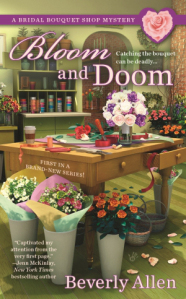 Let your sleuth think about and enjoy her occupation or hobby. Audrey Bloom evaluates her environment based on her point of view, and flowers, since they are important to her, color her world. And if this can tie in to the mystery as well? All the better. And it should be upbeat. I’m not sure too many readers want to hear the protagonist grouse about her job, especially if that job was the hook that brought them to the series in the first place.
Let your sleuth think about and enjoy her occupation or hobby. Audrey Bloom evaluates her environment based on her point of view, and flowers, since they are important to her, color her world. And if this can tie in to the mystery as well? All the better. And it should be upbeat. I’m not sure too many readers want to hear the protagonist grouse about her job, especially if that job was the hook that brought them to the series in the first place.
Remember your audience. Cozies will always have detractors who say that adding these details into a mystery is filler. But if you’ve seen the lovely covers Berkley has designed for my books, you’ll understand that many of the readers who pick up the books enjoy flowers, and they expect to see them displayed prominently in the mystery as well. Will it be too much for some readers? Yeah, well, not everyone will enjoy the same books. But for the most part, readers who read culinaries enjoy the cooking, people who read needlecraft mysteries enjoy their crafts, and people who read books covered with flowers probably like flowers.
I’m beginning to love flowers. In theory. And at a distance.
 Beverly Allen writes cozy mysteries with a healthy dose of comedy and sometimes a splash of romance. The first two books in the bestselling Bridal Bouquet Shop Mystery series: Bloom and Doom and For Whom the Bluebell Tolls are now available from Berkley Prime Crime, with the third, Floral Depravity, set to release in October.
Beverly Allen writes cozy mysteries with a healthy dose of comedy and sometimes a splash of romance. The first two books in the bestselling Bridal Bouquet Shop Mystery series: Bloom and Doom and For Whom the Bluebell Tolls are now available from Berkley Prime Crime, with the third, Floral Depravity, set to release in October.
Beverly grew up in the suburbs of Buffalo, NY. When not reading or writing, she enjoys cooking, crafts, home-improvement projects, and spending time with her husband, daughter, and four naughty, but adorable cats.
Filed under: Guest posts Tagged: allergic to flowers, Barbara Early, Beverly Allen, Bloom and Doom, flower allergies, flower arranging, For Whom the Bluebell Tolls

January 26, 2015
On Multi-tasking
Edith here, having co-shoveled out half a foot of snow on Saturday.
People often ask me if I work on more than one book at a time. I answer, “By preference, I don’t.” I’ve read of studies that report multi-tasking yields results like those of elderly people losing focus. While I’m not quite elderly (at least by my definition!), I do have three -well, four – series under contract, and I need focus to keep the protagonists and their settings distinct.
So I try to shovel out one series at a time. I’ll write the first draft for this one. Then put it down and incorporate copyedits on another one. Then write a blog post or work on an invited lecture for a third. Preferably not all on one day. Because the last thing readers need is me switching from first person voice (Country Store Mysteries) to third (Local Foods Mysteries). Or seeing my introverted geek farmer (Local Foods Mysteries) do something only my extroverted 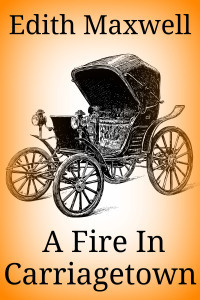 Quaker linguistics professor would do (Lauren Rousseau Mysteries). Or, heaven forbid, have my 1888 midwife use a phrase like “it was hard for me to get centered,” a distinctly twentieth-century usage when it pertains to something like meditation or Quaker worship.
Quaker linguistics professor would do (Lauren Rousseau Mysteries). Or, heaven forbid, have my 1888 midwife use a phrase like “it was hard for me to get centered,” a distinctly twentieth-century usage when it pertains to something like meditation or Quaker worship.
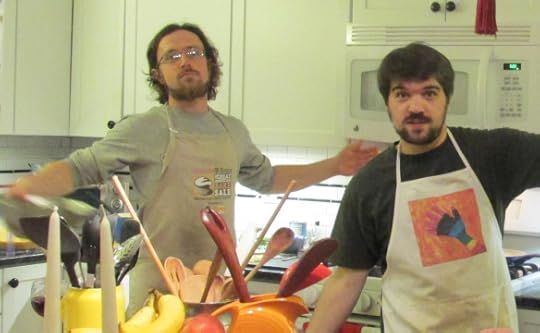
JD and Allan making my birthday dinner. And listening to music. And dancing. And being handsome. (And you just missed the yoga stretches…)
On the other hand, I’ve also seen my twenty-something sons listen to music, check fantasy sports results, cook a multi-course gourmet dinner, carry on a conversation, and do yoga stretches almost simultaneously. And nothing seems to be wrong with their brains. On the contrary, they are super productive, well adjusted, caring, and handsome to boot. (Okay, hanging around being handsome isn’t quite multi-tasking, but I’m their mom, so I can throw that in.) They have yet to be authors of multiple series, although I wouldn’t be surprised if that happened one day.
Back to my own multi-tasking, though: one day last week I finished going through proofs for FARMED AND  DANGEROUS. I heard that my editor accepted FLIPPED FOR MURDER and I figured out how to implement the changes he wants. I changed the murder weapon for BISCUITS AND SLASHED BROWNS because I learned another author had recently used that exact same unusual method. And I printed out COMPOST MORTEM for final revisions. Four at one blow on one day. And that’s only two of the four series. Whew!
DANGEROUS. I heard that my editor accepted FLIPPED FOR MURDER and I figured out how to implement the changes he wants. I changed the murder weapon for BISCUITS AND SLASHED BROWNS because I learned another author had recently used that exact same unusual method. And I printed out COMPOST MORTEM for final revisions. Four at one blow on one day. And that’s only two of the four series. Whew!
Not long ago when I was a technical writer in the software industry, one guiding principle was, “White space is your friend.” If you load up a page with too much information, readers can’t absorb it, and that was when we actually printed software manuals. Maybe brains are the same way. But, then as now, lists were also my friends. Making a list every morning totally helps me cope with my multiple tasks for the day. Constants are: “Write” and “Exercise.” Everything else follows, and some days the reality is that I have to work on two or three or four books. But at least I have something to check off!
So how do you deal with multi-tasking? Readers, what do you make lists of? Everyone, how do you cope with multiple commitments? Writers, do you try not to work on more than one project at a time, or can you easily switch between books, posts, series?
Filed under: Edith's posts Tagged: Carriagetown Mysteries, Country Store Mysteries, Farmed and Dangerous, Flipped for Murder, lauren rousseau mysteries, local foods mysteries, multitasking, mystery

January 23, 2015
Cherished Playthings
Jessie: In New Hampshire, feeling grateful for hearty soups and robust heating systems.

We’re taking a nostalgic and light-hearted approach to our group post today. Most people had a favorite childhood plaything. A toy, a game, a stuffed animal. So Wickeds, what were the things you would have saved from a burning house when you were a kid? Which toys were the ones you used for hours on end? Do you still have any keepsakes from your childhood?
Liz: I love this! When I was in fourth grade, Cabbage Patch Kids were all the rage. Anyone who remembers that fad will recall demand, lines and arguments rivaling those at the Apple store on a new iPhone launch day. My mother made many valiant efforts, to no avail. I was starting to see my dreams of my very own Cabbage Patch doll fading before my eyes.
After one particularly depressing day at school when a classmate brought her new doll in for show and tell, I went home and told my mother again how sad I was about the situation. She assured me she was trying, and I should be grateful for the things I have, and could I please go downstairs and get the potatoes from the basement? So I did, with the weight of the world on my shoulders, feeling sorry for myself. And when I reached the potato bin, there was a Cabbage Patch Kid box sitting in it. Her name was Andi Gizela, and I was over the moon. I still have Andi. Currently she’s in a keepsake chest. Whenever I have cause to take her out, I still imagine she smells like the baby powder scent all the dolls had. Still one of the best days of my childhood.
Julie: I love Liz’s story. I had a rock and roll Barbie and walking Ken. My grandmother made Barbie clothes (one AMAZING knit dress I would love to have, but got worn out).I loved my Barbie, and would put her in her case, put the whole thing in the basket on the back of my bike, and haul it across town to Julie D’Antono’s house. Julie had all the Barbie stuff–camper, house, etc. I had none of that, but made beds out of kleenex boxes, and could do amazing things with paper towels. Ken was limited in his mobility, but was the nice guy next door. My youngest sister thought Ken lacked, and got Kung Fu grip G.I. Joe as a partner for her Barbie.
One other very treasured toy was a dollhouse my grandfather made for us, including the furniture. We spent hours playing with it, and I still love looking at it.
Barb: I still have my Barbie doll, and the elegant evening gown my grandmother knit for her on little tiny needles. There was always a shortage of Kens, so I remember life in Barbie-land was a soap opera of constantly changing partners. I also still have my Tiny Tears, and Tiki, a stuffed dog with a huge patch on his back that I took everywhere when I was small. I was told my father gave him to me before he left for Korea.
But the toy I would save, should such an occasion arise, is my daughter’s Cabbage Patch preemie, Derick. Derick has been everywhere–camp, vacations, sleepovers, France, Italy, Australia, college. He’s what my niece who studied developmental psychology calls a personified object, very close apparently to an imaginary friend. I guess what I am saying is, Derick is part of the family, so he’d be the one to be rescued from the flames. And Derick’s head still smells like baby powder, too.
Edith: I love Liz’s story, too, and the image of a Cabbage Patch preemie. I still have my stuffed dog, Topsy, who is nearly as old as I am. The inside of his ear was silky and I’d stroke it 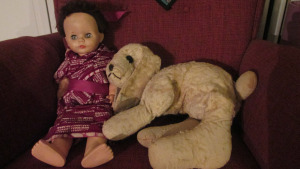 for comfort (probably sucking my thumb, while I was at it). He was originally a Dalmation – well, at least he used to have spots. I did a lot of surgery stitching him up when his stuffing tried to come out. And I still have my Edith doll (yes, I used to have dark hair). She had an unfortunate haircut somewhere along the line, and her wrap-around dress is because I have no idea where her original clothes went.
for comfort (probably sucking my thumb, while I was at it). He was originally a Dalmation – well, at least he used to have spots. I did a lot of surgery stitching him up when his stuffing tried to come out. And I still have my Edith doll (yes, I used to have dark hair). She had an unfortunate haircut somewhere along the line, and her wrap-around dress is because I have no idea where her original clothes went.
I have one remaining Barbie doll, for which my grandmother sewed some amazing clothes, a feat which would defeat me as a seamstress – do you even know how freaking tiny those sleeves are?!. But I also have books galore from my childhood. Original Oz books. The Laura books, much read. My mother’s Mother Goose Nursery Rhymes. The Little Engine That Could. The Story of Babar. And on and on. And on. What a fun trip down memory lane.
Jessie: I wasn’t really one for Barbies but I absolutely loved the Fisher Price Little People. My sister and I had the suburban house with a doorbell that rang and the hospital with a working elevator. I played with those for hours on end. The house opened to allow access to four rooms: a kitchen, a living room and two bedrooms. There was even an attached garage. I remember being baffled and annoyed by the lack of a bathroom. Its absence plagued me. Then I realized it had a set of freestanding stairs with a little closet built underneath. I decided to turn that into the bathroom. I consider it to be my first home renovation project!
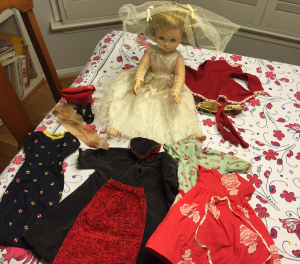 Sherry: I loved dolls. Any kind of dolls from baby dolls to Barbie dolls. I spent hours with them. I have a couple left. One is a bride doll. My mom spent countless hours sewing clothes for her after we’d gone to bed. I’m not sure if you can tell in the picture but she also had shoes, skates, nylons and a purse. One of my other favorite dolls was my Shirley Temple. Somehow even with all of the moves I still have her, a purse and her
Sherry: I loved dolls. Any kind of dolls from baby dolls to Barbie dolls. I spent hours with them. I have a couple left. One is a bride doll. My mom spent countless hours sewing clothes for her after we’d gone to bed. I’m not sure if you can tell in the picture but she also had shoes, skates, nylons and a purse. One of my other favorite dolls was my Shirley Temple. Somehow even with all of the moves I still have her, a purse and her  rain outfit which included a purse, coat and scarf to protect her hair. I still have one Barbie doll too but it was originally my sister’s. It’s a blonde bubble head that I always thought was so beautiful.
rain outfit which included a purse, coat and scarf to protect her hair. I still have one Barbie doll too but it was originally my sister’s. It’s a blonde bubble head that I always thought was so beautiful.
Readers: What toy did you love when you were little? Do you still have it?
Filed under: Group posts Tagged: Babar, Barbie doll, Bride doll, childhood, Fisher Price Little People, games, nostalgia, Shirley Temple doll, stuffed animals, The Wizard of Oz, toys, vintage toys

January 22, 2015
The Invidious Comparison
by Barb, still in Key West
Our readers get to see the blog posts, but as we’ve told you before, there’s a lot the goes on behind the scenes here at Wicked Cozy Authors, Inc. The Wickeds cheer each other on as we struggle through first drafts, race toward deadlines, wait anxiously for word from our editors that a manuscript has been accepted, or from our agent that a series has been sold. I can’t tell you how much that moral support has meant to me.
But, as a result, I’ve learned a lot about my fellow Wickeds work habits.
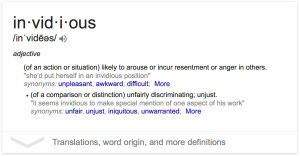 Julie can plot a whole book before she writes it. I can’t do that. Jessie can write more than 5000 first draft words in a sitting. I’ve never done that. Sherry can write the beginning, then write the end, then swoop back and do some of the middle. I did that once with a short story, but I’ve never achieved it with a novel. Liz can balance writing two series with a full-time, serious job. I couldn’t do that when I was her age, and I certainly can’t do it now. And Edith can complete her entire daily word count before I am even out of bed.
Julie can plot a whole book before she writes it. I can’t do that. Jessie can write more than 5000 first draft words in a sitting. I’ve never done that. Sherry can write the beginning, then write the end, then swoop back and do some of the middle. I did that once with a short story, but I’ve never achieved it with a novel. Liz can balance writing two series with a full-time, serious job. I couldn’t do that when I was her age, and I certainly can’t do it now. And Edith can complete her entire daily word count before I am even out of bed.
This is all fascinating, and believe me, I am happy for the skills and achievements of my friends, but sometimes, when I compare myself to them, I feel a little…envious. It’s the Invidious Comparison.
I was lucky to have a lot of mentors when I was coming up in the corporate world, and it was one of them who explained to me, when I was quite a young manager, the Invidious Comparison.
 Invidious actually means likely to arouse or incur resentment or anger in others, but the way she used Invidious Comparison, it meant that situation when we are jealous of something we don’t even particularly want. The classic example is your brilliant sales person. She’s a lone wolf, she loves killing what she eats, creating her own rewards by living on commission. She hates paperwork and managing others, and the thought of tying her success to that of subordinates gives her hives. She’s happy in her job, and you’re thrilled to have her. But then time goes by. People who were hired after her, people who might not even have been as good at sales as she is, get promoted into management. They have other talents. They are good mentors and bosses. They love the minutiae of paperwork, the discipline of the sales pipeline, the feeling of having a team. And the brilliant sales person, in spite of herself, even though she would rather die than be a manager, starts to get jealous. Sooner or later, one of these promoted people ends up being her boss. And it drives her crazy. Even though she doesn’t want the job.
Invidious actually means likely to arouse or incur resentment or anger in others, but the way she used Invidious Comparison, it meant that situation when we are jealous of something we don’t even particularly want. The classic example is your brilliant sales person. She’s a lone wolf, she loves killing what she eats, creating her own rewards by living on commission. She hates paperwork and managing others, and the thought of tying her success to that of subordinates gives her hives. She’s happy in her job, and you’re thrilled to have her. But then time goes by. People who were hired after her, people who might not even have been as good at sales as she is, get promoted into management. They have other talents. They are good mentors and bosses. They love the minutiae of paperwork, the discipline of the sales pipeline, the feeling of having a team. And the brilliant sales person, in spite of herself, even though she would rather die than be a manager, starts to get jealous. Sooner or later, one of these promoted people ends up being her boss. And it drives her crazy. Even though she doesn’t want the job.
The Invidious Comparison.
So every morning, when I tumble out of bed and see that Edith has posted that she’s already made her word count and is off to have fun adventures on the day, I’m a little jealous.
Or I might plan a long weekend and think I am going to write 15,000 words in three days, like Jessie. But I will inevitably fail. And send myself through a whole guilt, grief cycle which will waste even more time.
The Invidious Comparison.
It’s ridiculous, I know. If I got up and got my word count done like Edith does, I’d be obliterating my absolutely favorite thing about not having a corporate job–sleeping in and staying in my pjs until after my second cup of coffee. I love it. It makes me so happy.
And if I were capable of binge-writing, first of all, it would make me an even worse procrastinator than I am. And secondly, it would take me back to the way I wrote when I had kids and a full-time job, which I didn’t enjoy nearly as much as I enjoy my writing schedule now.
I can’t do what they can do.
So I have to play to my strengths–to wit, a certain relentlessness, and a great fear of shame in the public square if I turn in a really awful book. Or no book at all.
It works for me.
Each of the Wickeds has different strengths, different weaknesses and different ways of working. When I’m seeing clearly, I know that’s part of what makes it all work. It’s part of what goads each of us to be better and try new things. But if we try them, and they aren’t helpful, it’s fine to set those new things down and move on.
People love to tell you that if you don’t do such and such, you can’t write a book.
“If you don’t get up at 5:00 every morning and have your word count done by 10:00 am, you can’t write a book.”
“If you don’t write everyday, you can’t write a book.”
Poppycock. The disempowering message from these morons is, “You can’t write a book.”
But you can. You can produce one book every ten years if you want to. You can write only when the moon is full. You can self-publish a 400 page tome every three months. Do whatever you want.
Because if you’re not doing what you want, why are you doing it at all? There are plenty of easier ways to pass the time.
But when you choose one path, you can’t be jealous of the other people who go down a different path, and do it a different way, and find success.
Because that’s the Invidious Comparison.
Filed under: Barb's posts

January 21, 2015
Wicked Wednesday- Character Sketches
Jessie: Enjoying the contrast between the snow outside my window and the amaryllis blooming on the windowsill.
This month we’ve decided to all chime in on the process of writing proposals for book series. Mystery series are often sold this way, in fact all of us have sold series in this manner, some of us more than once. The format for doing this is fairly standardized in the publishing industry and each Wednesday this month we will dive into one aspect of the process. This week we are talking about writing character sketches for your proposal. Wickeds, how did you introduce your characters in something as short as a sketch?
Edith: Now that you mention it, a big part of the series description portion of my Country Store Mysteries proposal was the character sketch of Robbie Jordan. I had to make her different from Cam, the tall geeky farmer in the Local Foods Mysteries, and from Lauren, my Quaker linguistics prof in the Lauren Rousseau mysteries.

The woman in this photograph could almost be my protagonist.
So Robbie (Roberta) Jordan, originally a Californian, has fallen for the rolling hills of southern Indiana and also fell in love with all the vintage cookware available. Robbie, 27, is 5’3″, has curly dark hair from the father she never met, and struggles with her weight because of her love of cooking and eating what she cooks, although she’s fit from a bicycling habit and strong because of the carpentry she learned from her mom. She was also a puzzle champion in high school and still does difficult puzzles every day to relax, which helps her solve mysteries, too! I also love some of the secondary characters, including her tough old aunt Adele, who raises sheep and can also handle a gun. And when I realized how much work running a restaurant was, Danna popped onto the page full blown, a nineteen-year-old tall local daughter of the mayor with gold-red dreadlocks. She wants to cook instead of going to college and turned out to be a great sidekick. Robbie’s African-American friend Phil popped in, too. A singer and an artist, he also bakes all the desserts for the restaurants and is a loyal friend.
Barb: Thanks for this trip down Memory Lane, Wickeds! Unfortunately, I think I’m the Wicked with the least recent proposal and my memory isn’t all that good. It’s hard to remember where the characters in the Maine Clambake Mystery series came from. I do know it was a conscious choice to make Julia Snowden thirty years old. The protagonist in my first book was my age when I started writing it, married with two kids, like me. I wanted something different for this book. I thought making her an age where hard decisions about the future press in would make for an interesting series.
I knew I wanted an antagonist for the series, and that’s where Julia’s brother-in-law Sonny comes from. He’s a traditionalist, so he fights every change she wants to make to the clambake. I don’t know where Julia’s sister Livvie came from, but all of the female protagonists in my novels have sisters. I do not have a sister. Paging Dr. Freud! Chris Durand and Gus Farnham are to some degree modeled on real people. With Chris, not so much the hunky, sexy part, but the having three jobs and scrambling to make a living in a resort economy. We do have a friend in Boothbay who works as a bouncer and drives a cab, and I’ve always found the idea of taking away some tourist’s keys and then loading him into a cab you own and charging him for the ride to be the ultimate small town situation. Gus’s I’ve described pretty much as it was. Julia’s mother Jacqueline, niece Page, and cop friend Jamie round out the cast. The state cops, Binder and Flynn, weren’t in the original proposal. They came later.
Liz: When I wrote my original character sketch for Stan Connor in the Pawsitively Organic Mysteries, I had a pretty good picture of her already. Aside from being blond and tall (think Blake Lively) I wanted her to be someone with a lot of contradictions, like the fact that she’d thrived in corporate America but really didn’t have a lot of the cutthroat traits that people in those positions usually possessed. I wanted her to be financially independent, not poor and struggling. And I knew, just from exploring her upbringing and comparing that with the person I’d created, that she’d have a lot of relationship baggage. I also wanted her to find some really great people when she moved to Frog Ledge – unique but loyal friends like Char and Ray Mackey and her love interest Jake McGee. Her best friend Nikki, a dog transporter and animal activist, is my “say anything” character – the person I can assign all those lines that Stan would never say. I love her.
In my upcoming series, I knew immediately that Maddie James would be very different from Stan. Where Stan is polished and tends to live on the quieter side, Maddie is more in-your-face. She’s a born leader and entrepreneur, and has very strong opinions. And, she’s a brunette. Her sidekick is her Grandpa Leo, who’s the former police chief on Daybreak Island, her hometown and where the series takes place. I’m having a lot of fun in her head.
Jessie: For me the character sketches are easiest to write after I’ve done the first 50 pages of the manuscript. I write in scenes and I generally know what bit of business I am trying to accomplish at any point in the work but I don’t necessarily consciously know what the characters are like until I start writing them. Like Barb, with her realization that she wanted to provide a strong antagonist, I usually have a clear sense of the roles I want and need to fill to tell the story. What I don’t know is the voice they will use or the attitude they will have about any of it. I find that I end up blocking out action and goals and then I sit down and start writing. Mercifully and magically the people seem to show up, mostly full-blown on the page like they are talking right into my ear.
In my Sugar Grove mysteries I knew my main character, Dani Greene, was the youngest in her family and that she lived on her family’s farm with a lot of relatives. By the end of the first 50 pages I knew everyone in her immediate orbit and I could backtrack and write a synopsis of each of them. When it came to crafting the character sketches themselves I tried to adhere to the advice I heard somewhere once that such things should create impressions rather than conduct inventories. I try to succinctly convey the emotional temperature of the characters and their goals and fears rather than their physical descriptions etc…
Barb, my books always have sisters too! But I have sisters of my own so I wonder if we would get the same diagnosis?
Barb: Jessie, interesting you wrote the pages first, then the proposal. I did it the other way around. How did others do it?
Sherry: Writing character sketches is a great time to show not tell what your story is about. How is your character different from other authors characters? How do they add conflict to the story? I wanted to have a protagonist who had some connection to the military because I loved being an Air Force wife. I also wanted to make sure Sarah couldn’t run to someone on the police force for help. So Sarah is newly divorced from a husband who was in the Air Force. Her ex is now the police chief of the small town they live in. It was one way to create conflict in the series. I might have mentioned this before but about a month before I wrote the proposal I’d edited Clammed Up for Barb. I loved her character Gus — he was funny, gruff, and wise all at once. I created Angelo. I borrowed heavily from the personality of a neighbor of ours in Bedford, Massachusetts but amped him up from the original. Angelo has a lot of opinions but they usually have a point. He’s one of my favorite characters. I wrote the chapters first and then the sketches from there.
Julie: Again, different perspective since I was hired to write according to a bible. I had a list of characters, and a couple of sentences about each. For a proposal, you don’t need much more than that. But, in order for me to write my sample chapters, I needed to really understand each of them a bit more. So I visualized them. “Handsome guy next door” became Robert Redford in THREE DAYS OF THE CONDOR, for example. Just remember, you need a victim, a protaganist/sleuth, a sidekick, a foil for the protaganist (maybe someone who seems guiltly, or creates tension in a subplot.) Casting your cozy is important. It helps people understand that you understand the form. And it lets them know that you are creating a world they all want to visit over and over.
Edith: For the Local Foods proposal, Barb, I had a draft of the pages from fifteen years earlier, and I’d already created the world, so that helped. For the Country Store series, I kind of went back and forth. I sketched out the characters, wrote some, and then went back and made sure my character sketches matched who had emerged on the page.
Readers–do you have questions or comments about character sketches in proposals?
Filed under: character synopses, Craft, Dani Greene, Group posts, Sugar Grove Mysteries, Wicked Wednesday Tagged: character sketches, Country Store Mysteries, Kensington Publishing, maine clambake mysteries, mystery series, Pawsitively Organic Mysteries, writing, writing mysteries, writing proposals

January 20, 2015
The Detective’s Daughter — The Spirit of the Story
 Kim Gray in Baltimore trying to avoid the ice and rain.
Kim Gray in Baltimore trying to avoid the ice and rain.
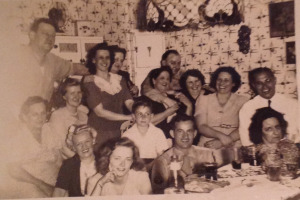
Aunt Evelyn is seated in the front row in the black jacket. My Dad is the young boy in the middle.
I never thought of story telling as an art. It was just something my family did when we sat around the table drinking coffee and eating the sandwiches my grandmother had made. My grandmother’s kitchen table was the command center of our family. Nana, as we called her, conducted her business here much like Michael Corleone did at his desk. If you needed a loan, a shoulder to cry on, a bit of advice or a hot meal, my grandmother’s kitchen was the place to come. Whether you were family, neighbor or friend, Nana was waiting to dish out what you needed.
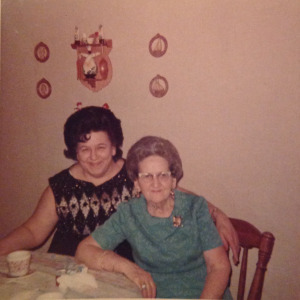
Big and Little Madeleines
On Saturday afternoons nearly every member of my extended family gathered for coffee, sandwiches and Utz potato chips we had bought that morning at the market. All of my favorite aunts, Betty, Evelyn, and both little and big Madeleines were always there, as well as my uncles Charles, Roy and Abe. It wasn’t long after the food was cleared before my grandfather and Uncle Roy broke out their guitars to play. In between verses of Won’t You Come Home Bill Bailey, they would share stories of their days on radio. I enjoyed hearing them tell of my

My famous Uncle Al, Uncle Roy and my grandfather
Uncle Al who had been a band leader and night club owner in Washington D. C. in the 1940’s. He had passed away long before I was born. The three of them along with my grandfather’s brother Joe, had played on a radio program on Sunday nights. I wished I could have heard them, but their stories made me feel as if I were there.
The best story teller was my Aunt Evelyn. I attribute my love of ghost stories and all things haunted to her. She was a slender woman with the blondest hair I have ever seen and the more scary  her story became the pinker her skin appeared. She would tell of the ghostly pirates who haunted her house still searching for treasure the had buried in the basement. There was also a woman who seemed to follow my uncle around in their kitchen. My aunt believed this woman to be the long deceased owner of her home. Aunt Evelyn told me the woman had rented rooms to the sailors whose ships had docked in Locust Point. Sometimes the story changed and the sailors became the pirates, but whichever version was told, she believed every word and I did, too. That’s what made her stories so interesting and memorable, she believed them, she was a part of them. The other aunts told stories, repeating what had happened or what they had been told, but never with her passion. Passion is what makes a story compelling.
her story became the pinker her skin appeared. She would tell of the ghostly pirates who haunted her house still searching for treasure the had buried in the basement. There was also a woman who seemed to follow my uncle around in their kitchen. My aunt believed this woman to be the long deceased owner of her home. Aunt Evelyn told me the woman had rented rooms to the sailors whose ships had docked in Locust Point. Sometimes the story changed and the sailors became the pirates, but whichever version was told, she believed every word and I did, too. That’s what made her stories so interesting and memorable, she believed them, she was a part of them. The other aunts told stories, repeating what had happened or what they had been told, but never with her passion. Passion is what makes a story compelling.
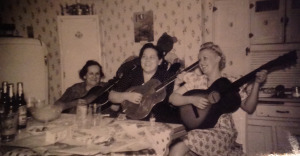
My great grandmother, my grandmother and Aunt Evelyn.
 Today, sitting at my own kitchen table listening to the rain pound against the window, I am drinking my coffee from the same cup I did as a child and reading one of my favorite ghost stories. From the corner of my eye I catch a glimpse of a very blonde woman who has become the star of her story and mine.
Today, sitting at my own kitchen table listening to the rain pound against the window, I am drinking my coffee from the same cup I did as a child and reading one of my favorite ghost stories. From the corner of my eye I catch a glimpse of a very blonde woman who has become the star of her story and mine.
Readers: Did your family tell stories?
Filed under: The Detective's Daughter Tagged: Ghost stories, storytelling, The Detective's Daughter, Utz potato chips

January 19, 2015
Launch Parties — To Party or Not to Party
By Sherry — I’m happy it’s warmer than last week!
Launch Parties. I wasn’t sure if I should throw one or not. I googled Launch Parties and panic set in. I saw discussions about bartenders, DJs, swag, decorations, themes. That was not for me.
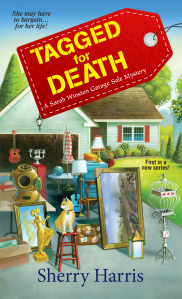 For a extroverted person I have this introverted part of me around promoting Tagged for Death. Standing up on my own, talking about my book scared the heck out of me. But that’s when I saw Ray Daniel’s post on Facebook talking about his launch party for Terminated. He had Hank Phillippi Ryan interview him. I thought that was a brilliant idea and something that would work well for me. Friends who attended Ray’s launch said it was fabulous.
For a extroverted person I have this introverted part of me around promoting Tagged for Death. Standing up on my own, talking about my book scared the heck out of me. But that’s when I saw Ray Daniel’s post on Facebook talking about his launch party for Terminated. He had Hank Phillippi Ryan interview him. I thought that was a brilliant idea and something that would work well for me. Friends who attended Ray’s launch said it was fabulous.
I asked friend, author, and independent editor Barb Goffman if she would interview me for the launch. Barb is also a journalist, funny, and enthusiastic. She said yes and a weight fell off my shoulders. I could do this. The next step was figuring out the venue. Have it at home? Rent a community center? Or have it at a bookstore? I sought the advice of friends. Some of their answers surprised me: make sure there’s lots of parking, bonus points for free parking, don’t make me drive through rush hour (Washington DC traffic can be a nightmare). Do you want this to be a marketing event or a celebration with family and friends? If you have it at your house or a community center who will handle book sales?
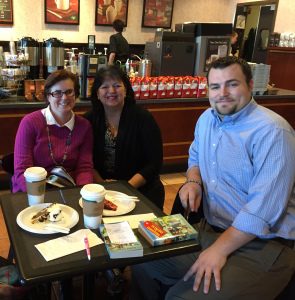 It was a lot to ponder. Fortunately for me my friend Mary Titone pushed me and called venues for me. Barnes and Noble at Fair Lakes Promenade in Fairfax, Virginia said they’d love to host my launch. Having it there fulfilled the lots of free parking and who would sell books suggestion. We set it up for 1:00 pm on a Sunday which avoided rush hour. Having it at the bookstore allowed for both a celebration and a marketing event.
It was a lot to ponder. Fortunately for me my friend Mary Titone pushed me and called venues for me. Barnes and Noble at Fair Lakes Promenade in Fairfax, Virginia said they’d love to host my launch. Having it there fulfilled the lots of free parking and who would sell books suggestion. We set it up for 1:00 pm on a Sunday which avoided rush hour. Having it at the bookstore allowed for both a celebration and a marketing event.
The staff at Barnes and Noble couldn’t have been nicer. Store manager Sarah Emmett arranged for Mary and I to meet with Ann, who’s in charge of the cafe, and John their events guru. Ann provided samples of baked goods and made sure I stayed within my budget. The day of the launch she even made sure we had our own private “butler” Alex to serve. John and Sarah made lots of great suggestions and showed us the space where the party would be. They all seemed so happy about the event and I couldn’t have worked with a nicer team.
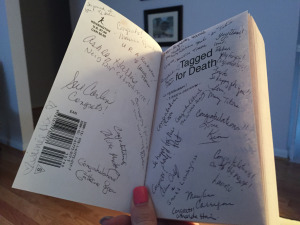 The night before the big day my friend Jill Ribler sent me a picture she’d found on Pinterest. An author had taken her own book and had people attending the launch sign it instead of having a guest book. It was a great idea which I incorporated into the launch. Two friends and fellow writers, Susan O’Brien and Robin Templeton, volunteered to take pictures.
The night before the big day my friend Jill Ribler sent me a picture she’d found on Pinterest. An author had taken her own book and had people attending the launch sign it instead of having a guest book. It was a great idea which I incorporated into the launch. Two friends and fellow writers, Susan O’Brien and Robin Templeton, volunteered to take pictures.
The launch itself was perfect. I choked up a bit during the thank you’s when I mentioned my husband and daughter. Barb Goffman was funny and asked great questions. Having her by my side kept me calm (well, calmer). I didn’t do a reading — it’s another thing I’m not crazy about doing.
I was delighted to have people from so many aspects of my life present. Friends we’d met at Hanscom Air Force Base in Massachusetts — Tagged for Death is set in a fictional version of the base and the small town of Bedford, Massachusetts, Chessie Chapter Sisters in Crime members, even one friend from the New England Chapter of Sisters in Crime, one Wicked Cozy Author, along with friends and neighbors. It surpassed the celebration I hoped for.
Thanks to all of you for making my launch party such a special day!
Filed under: Sherry's posts Tagged: Barb Goffman, Barnes and Noble, Bedford Massachusetts, Chessie Chapter of Sisters in Crime, Fair Lakes Promenade, Fairfax, hank phillippi ryan, Hanscom Air Force Base, Launch Parties, Mary Titone, New England Chapter of Sisters in Crime, Ray Daniels, Sarah Emmett, Terminated, VA

January 16, 2015
Welcome Back, Author Lea Wait
by Barb, in sunny, warm Key West (don’t hate me)
 Regular readers of the blog will remember my friend author Lea Wait was here in September. Then she talked about the latest book in her Shadows Antique Print series, Shadows on a Maine Christmas. At the time, she mentioned her new Mainely Needlepoint mystery series was coming soon. Well now the first book in the series, Twisted Threads, is here and we’ve asked Lea back to answer some questions about it.
Regular readers of the blog will remember my friend author Lea Wait was here in September. Then she talked about the latest book in her Shadows Antique Print series, Shadows on a Maine Christmas. At the time, she mentioned her new Mainely Needlepoint mystery series was coming soon. Well now the first book in the series, Twisted Threads, is here and we’ve asked Lea back to answer some questions about it.
About Twisted Threads: Angie Curtis had a rough Maine childhood, which only got worse when she was ten and her mother disappeared. At eighteen, Angie took off for any place other than Maine and ended up working for a private investigator in Arizona. Now she’s 28, her mother’s body has been found, and Angie returns to Haven Harbor vowing to find her mother’s killer. When she finds her grandmother’s needlepoint business is in trouble, she also agrees to help out there. She doesn’t know “helping out” will mean solving another murder, and confronting some of her childhood fears.
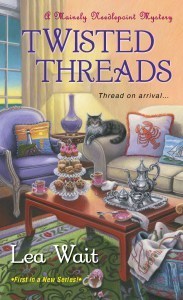 Barb: While you’ve always written more than one thing, because you write for children and adults, Twisted Threads is the first book in your second mystery series for adults. How did you think about creating a second series? Was it a very different experience than creating the world of the Shadows mysteries?
Barb: While you’ve always written more than one thing, because you write for children and adults, Twisted Threads is the first book in your second mystery series for adults. How did you think about creating a second series? Was it a very different experience than creating the world of the Shadows mysteries?
Lea: When I started the Shadows series I hadn’t been published. Truthfully, I wrote the first in the series (Shadows at the Fair) to prove to myself that I could sustain a book-length manuscript. I was focused on writing one book at a time. For fun, I made each Shadows Antique Print mystery reflect a different classic mystery tradition, from the Gothic house mystery (Shadows on the Coast of Maine) to the academic mystery (Shadows on the Ivy) to the wedding mystery (Shadows on a Cape Cod Wedding) and the Christmas mystery (Shadows on a Maine Christmas).
 I was a beginner: I didn’t think through my decision to set different books in the series in different places. (Maggie Summer is an antique print dealer who travels to do antique shows and visit friends.) Some readers who grew attached to various characters, like Maggie’s best friend, Gussie, wanted their favorites to appear in every book in the series. I’d consciously hoped to avoid the “Cabot Cove” syndrome in which eventually everyone in the village seems destined to die. But, instead, I set up a different challenge.
I was a beginner: I didn’t think through my decision to set different books in the series in different places. (Maggie Summer is an antique print dealer who travels to do antique shows and visit friends.) Some readers who grew attached to various characters, like Maggie’s best friend, Gussie, wanted their favorites to appear in every book in the series. I’d consciously hoped to avoid the “Cabot Cove” syndrome in which eventually everyone in the village seems destined to die. But, instead, I set up a different challenge.
I know a lot more about writing mysteries now than I did when I set up the Shadows series!
Barb: Angie Curtis in the Mainely Needlepoint series is a very different protagonist than Maggie Summers in the Shadows mysteries. They’re different ages and have vastly different backgrounds. Because of this, the challenges they deal with and their goals are very different as well. How did you create Angie Curtis? Was it a conscious goal to keep her so far away from Maggie?
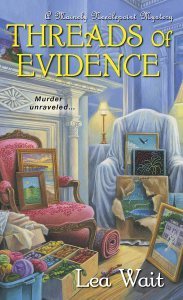 Lea: Yes! Angie is a high school graduate who grew up in Maine. She’s single and street-smart and 28. She’s worked for a private investigator, she knows how to shoot, she’s been known to drink too much, and there have been more men in her life than she’s willing to admit to anyone but herself.
Lea: Yes! Angie is a high school graduate who grew up in Maine. She’s single and street-smart and 28. She’s worked for a private investigator, she knows how to shoot, she’s been known to drink too much, and there have been more men in her life than she’s willing to admit to anyone but herself.
Maggie, on the other hand, grew up in suburban New Jersey, has a doctorate and is both a professor and an antique print dealer. She’s a widow in her late 30s who is hearing her time clock tick … she wants to be a mother. She has issues, too: she’s sometimes too focused on her jobs or on solving a crime to think of other people. And after a poor marriage, she has trouble trusting men.
Maggie can be brave; Angie can be reckless. Maggie wants to settle down; Angie needs to resolve issues left over from her childhood.
The Shadows books are from Maggie’s point of view, but written in the third person. The Mainely Needlepoint series is written in first person, so we see the world through Angie’s eyes.
As a writer, I wanted to challenge myself by choosing a heroine who was very different from Maggie. And I’m having a lot of fun learning to know Angie!
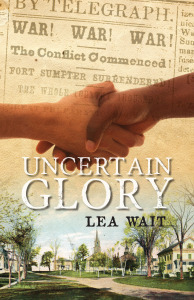
Uncertain Glory, Lea’s 2014 book for young people
Barb: Twisted Threads takes place in a harbor town in Maine, a setting I know you know a little something about. How did you create Harbor Haven and how is it both different than and similar to your real Maine town?
Lea: Hmmm. Yes. You do have a bit of knowledge about Maine harbor towns. I love both your home in Boothbay Harbor … and your books set in Busman’s Harbor!
The Shadow series does include a Maine community. Weymouth, a fictional village, is on a tidal river, very similar to real Maine towns like Bath and Wiscasset and Damariscotta. Again, in setting up a new series I wanted a new setting. Haven Harbor, Angie’s home town, looks out to sea. It has a working waterfront, a few tourist areas, and its own lighthouse and islands. (But no clam bakes!) It is more similar to your Boothbay Harbor, and to Belfast, and other towns in Down East Maine.
Barb: What are you working on now?
Lea: Kensington, the publisher we share, wanted a new Mainely Needlepoint book every six months (!) So this month I’m celebrating the publication of Twisted Threads, doing copy edits on Threads of Evidence, which will be published next August, and writing Thread and Gone, the third in the series. When I hit a rough spot or really need a break I work on the next Shadows book … Shadows on a Maine Morning. So – not bored in Maine this winter!
Readers–do you have a question or comment for Lea?
Biography: Maine author Lea Wait writes the 7-book Shadows Antique Print Mystery series and historical novels for young readers set in 19th century Maine. She adopted her four daughters as a single parent; now she’s the grandmother of eight, and married to artist Bob Thomas. For more information about Lea and her books, see her website www.leawait.com, and friend her on FB and Goodreads.
Filed under: Guest posts Tagged: Mainely Needpoint Mysteries, shadows antique prints mystery, Shadows on a Maine Christmas, threads of evidence, Twisted Threads

January 15, 2015
It’s A MARVELous World
By Julie, cold but cozy in Somerville
As I confessed in the comments when Jessie asked “To Binge or Not To Binge“, I am a Marvel fan. Movies and TV. Iron Man. Captain America. Thor. Agents of Shield. Agent Carter. The Avengers.
I am late to discovering this universe, and often need to be brought up to speed on backstory. A simple Facebook post asking “what is Captain America’s shield made of and why don’t they just shoot his ankles” brought forth several explanatory comments, including some citatations to different articles and explanations. There is an entire Marvel Encyclopedia. I am tempted.
Aside from the visceral thrill of super hero movies, these movies and TV shows are a great learning tool for me as a writer. Here’s what the Marvel world has taught me:
The best characters are complicated. The good guys are good guys, but they have struggles. Some of them walk a fine line, but usually end up on the right side.
You can create your own universe, but you still need to follow the rules you set up. Go outside the construct without explanation,and there needs to be a good reason, or reprecussions.
Story arcs are important. Apparently, the Marvel world of films has three phases. Each movie stands on its own, but knowing the other films helps inform the experience tremendously. The TV shows interweave with the movies. It all, surprisingly, makes sense. Also, threads are left hanging, to be resolved (or not) later.
The stories are well plotted. Each film is a little different, depending on the character, the screenplay, and the director. But they all move along at a satisfying clip.
The ride is thrilling. That is tougher to pull off in a book, but not impossible.
There is humor. Humor helps a lot.
Pulling all of this off, at this scale, is no small feat. It has been done before (any Babylon 5 fans out there?) and will be done again. Certainly a cozy series can’t have a visit by Captain America, but maybe it can be elevated by using a little Asgardian power plotting, a Stark Heart, Black Widow moves, and Avenger’s magic.
In fact, Marvel movies remind me a lot of cozy series (familiar characters, compelling stories, consistent settings) without the superpowers.
But don’t be surprised if Ruth Clagan (the protaganist in my series) wears a cape at some point.
Have any of you watched Agent Carter yet? I am greatly enjoying it!
Filed under: Julie's posts Tagged: Agent Carter, Marvel, Story Arcs


